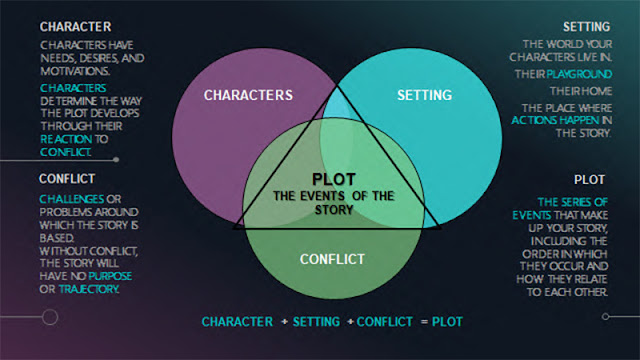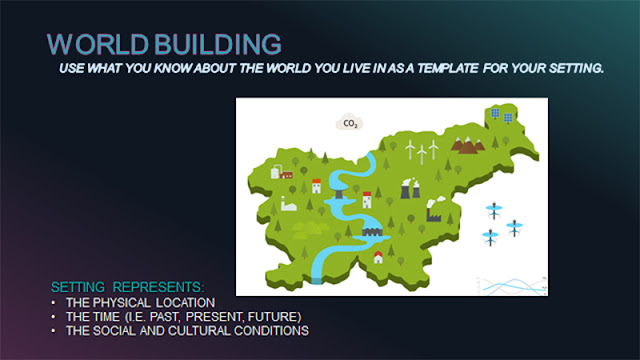Stories (novels, movies, television shows, and plays) are comprised of three key elements: Characters, Setting, and Conflict.
All three elements work together to create the journey. That journey is the story your audience will immerse themselves in.
Setting and Characters with no Conflict is boring.
Characters cannot act out or experience their Conflict without a Setting to do it in.
All three elements must be developed fully.
START BY BUILDING A BELIEVABLE WORLD FOR YOUR CHARACTERS TO LIVE IN.
You must have a sense of your world as a physical place if you want your characters to exist within it.
A character’s world plays a huge part in forming who they are. Characters are products of their environment.
Take inspiration from the world you live in, and decide how similar or different you want your fictional world to be.
- Geography
- Environment
- Society
- Religion
- Politics
- History
CHARACTERS DO NOT HAVE TO BE LIKE-ABLE BUT THEY DO NEED TO BE REAL!
As their creator you must understand what makes your characters tick, so you know how they'll react to the conflict you throw at them.
Know your characters. Create a character bible or rule book to establish their individual personalities. Understand their likes and dislikes. What motivates them? What are their goals and aspirations? Know what role they are meant to fill within your story.
If you write a character who does terrible things without any reason, readers will not connect with those characters..
Get your reader to understand why your character is doing something —good or bad — and they'll be more likely to support and root for your character. (Even if that character is morally ambiguous.)
REAL CHARACTERS RELY ON READER EMPATHY
A character is endearing when they mirror us in some way.
They have “Like Me” Qualities.
▪ Have Flaws / Quirks
▪ Bad Days / React Poorly to Their Situation
▪ Have Fears and Phobias
▪ Have Dreams and Aspirations
CONFLICT IS THE KEY TO DEVELOPING CHARACTERS
▪Choose a conflict that matters to the characters.
A relationship between two people breaking down can be just as important as the fate of the entire universe.
▪Employ internal and external conflict to create tension.
Tension is strongest when it attacks from within as well as outside of your character.
▪Create multiple sources of tension.
We all deal with conflict and tension from multiple sources, and your characters shouldn’t be different.
▪Keep raising the stakes.
Your characters need a challenge. They should try and fail a number of times. No easy wins.
SETTING + CHARACTERS + CONFLICT = PLOT
PLOT THEME
The combination of the three key elements with a primary theme (one large conflict) that sets the story in motion.
The combination of the three key elements with a primary theme (one large conflict) that sets the story in motion.
Overcoming The Monster (rebellion)
Defeat an antagonistic force (often evil) which threatens the protagonist and/or protagonist's homeland.
Rags To Riches
The poor protagonist acquires power, wealth, and/or a mate, loses it all and gains it back, growing as a person as a result.
Hero’s Journey
The protagonist goes to a strange land and, after defeating the villain, returns with experience.
Rebirth
An event forces the main character to change their ways and become a better person.
Underdog (sports / heist / contest)
A loner or outcast with a special talent. Joins a group who needs their special talent. Group conflict threatens to break them up, but they come together in the end to win the day.
The Quest
The protagonist and companions set out to acquire an important object or to get to a location. They face temptations and other obstacles along the way.
Comedy
Light and humorous, conflict becoming more confusing and ridiculous until characters triumph over adverse circumstance, resulting in a successful or happy conclusion.
Tragedy
The protagonist's character flaw or great mistake leads to their undoing.
PLOT STRUCTURE
The order of plot elements as they play off each other during the course of the story.
THREE-ACT STRUCTURE
ACT I
EXPOSITIONOPENING IMAGE
Snapshot of the Main Characters Normal life.
STORY THEME REVEALED
What is the theme of the story? What expectations can we set up?
SET UP THE JOURNEY
What will the Main Character need to do to reach the goal of the story?
RISING ACTION
DEBATE
The journey will be scary. Will the Main Character go?
CATALYST
Something forces the Main Character to go on the journey.
ACT 2
RISING ACTION (CONTINUED)
THE CHOICE
The Main Character chooses to go on the journey.
PROMISE OF PREMISE
The journey is not what was expected. Harder.
B STORY
Side quest or strength given to Main Character to continue on the journey through Secondary Character interaction or support.
CLIMAX
TWIST. KINK IN THE PLAN.
False victory or early defeat.
BAD GUYS CLOSE IN
Enemies are everywhere. Infighting happening with Main Character and Allies.
ACT 3
FALLING ACTIONAll seems lost. Huge Defeat. Rock Bottom. Can the MC recover and get back on track?
RESOLUTION
DIG DEEP
Find a new, better plan. Choose to continue fighting.
REASSEMBLE THE TROOPS
Set up the final confrontation.
FINALE
The big win! Reward. Celebration. Character reflection on what happened.
Related Post: 7 Story Structures Any Writer Can Use - Jerry Jenkins







